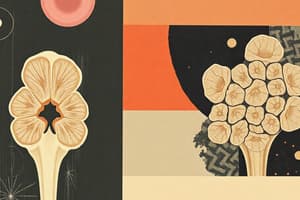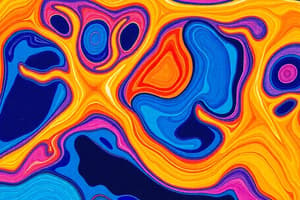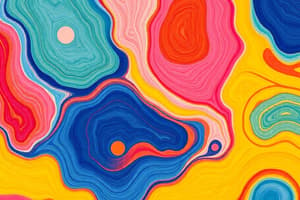Podcast
Questions and Answers
What are the three components that form connective tissue?
What are the three components that form connective tissue?
- Platelets, Ligaments, and Cartilage
- Cells, Blood vessels, and Neurons
- Cells, Fibers, and Ground substance (correct)
- Collagen, Elastin, and Matrix
Which characteristic is true about cartilage?
Which characteristic is true about cartilage?
- It has no blood supply and relies on diffusion (correct)
- It is vascular and contains nerves
- It is formed primarily of blood vessels
- It contains numerous lymph vessels
Which type of cartilage is characterized by a glassy appearance?
Which type of cartilage is characterized by a glassy appearance?
- Hyaline Cartilage (correct)
- White-fibro Cartilage
- Yellow Elastic Cartilage
- Calcified Cartilage
What is the primary function of the perichondrium?
What is the primary function of the perichondrium?
What type of cells are chondroblasts?
What type of cells are chondroblasts?
Where can hyaline cartilage be found in the body?
Where can hyaline cartilage be found in the body?
What is the ground substance in cartilage responsible for?
What is the ground substance in cartilage responsible for?
Which layer of the perichondrium is involved in the formation of new cartilage?
Which layer of the perichondrium is involved in the formation of new cartilage?
What type of growth is characterized by the proliferation of chondrocytes leading to cartilage growth from the outside?
What type of growth is characterized by the proliferation of chondrocytes leading to cartilage growth from the outside?
Which type of cartilage is characterized by the presence of large amounts of branching yellow elastic fibers?
Which type of cartilage is characterized by the presence of large amounts of branching yellow elastic fibers?
What structure is NOT covered with perichondrium?
What structure is NOT covered with perichondrium?
What is the primary component responsible for the basophilia of cartilage matrix?
What is the primary component responsible for the basophilia of cartilage matrix?
Where is white fibro cartilage commonly found?
Where is white fibro cartilage commonly found?
What function does hyaline cartilage NOT perform?
What function does hyaline cartilage NOT perform?
Which characteristic about mature chondrocytes is TRUE?
Which characteristic about mature chondrocytes is TRUE?
What is the main role of the superficial chondrocytes in the cartilage?
What is the main role of the superficial chondrocytes in the cartilage?
Flashcards
What is cartilage?
What is cartilage?
A type of connective tissue that provides support and flexibility to the body.
What are the components of cartilage?
What are the components of cartilage?
Cartilage is made up of cells, fibers, and a gel-like substance called ground substance.
How does cartilage get its nutrients?
How does cartilage get its nutrients?
Cartilage does not have its own blood supply. It receives nutrients from surrounding tissues or fluids.
What is the perichondrium?
What is the perichondrium?
Signup and view all the flashcards
What are the layers of the perichondrium?
What are the layers of the perichondrium?
Signup and view all the flashcards
What are chondroblasts?
What are chondroblasts?
Signup and view all the flashcards
What are chondrocytes?
What are chondrocytes?
Signup and view all the flashcards
What is hyaline cartilage?
What is hyaline cartilage?
Signup and view all the flashcards
Interstitial growth of cartilage
Interstitial growth of cartilage
Signup and view all the flashcards
Chondrocytes
Chondrocytes
Signup and view all the flashcards
Appositional growth of cartilage
Appositional growth of cartilage
Signup and view all the flashcards
Isogenous Groups (Cell Nests)
Isogenous Groups (Cell Nests)
Signup and view all the flashcards
Elastic Cartilage
Elastic Cartilage
Signup and view all the flashcards
Where is elastic cartilage found?
Where is elastic cartilage found?
Signup and view all the flashcards
Fibrocartilage
Fibrocartilage
Signup and view all the flashcards
Hyaline Cartilage
Hyaline Cartilage
Signup and view all the flashcards
Study Notes
Cartilage Overview
- Cartilage is a type of connective tissue
- Consists of cells, fibers, and ground substance
- The ground substance and fibers form the extracellular matrix
- Types of matrices include soft (connective tissue proper), firm (cartilage), and calcified (bone)
Cartilage Characteristics
- Originates from primitive mesenchymal cells (UMCs)
- Avascular (nourished by diffusion from surrounding connective tissue or synovial fluid)
- Lacks lymph vessels and nerves
- Usually covered by perichondrium (exception: white fibrocartilage)
Types of Cartilage
- Based on the amount of ground substance and fiber type
- Three primary types: hyaline, yellow elastic, and white fibrocartilage
Hyaline Cartilage
- Most common type
- Translucent, glassy appearance
- Locations:
- Costal cartilages
- Fetal skeleton's long bones
- Articular cartilage
- Trachea and bronchi
Hyaline Cartilage - Perichondrium
- Connective tissue membrane on cartilage's surface
- Two layers:
- Outer fibrous layer (collagen fibers, fibroblasts, blood vessels)
- Inner chondrogenic layer (chondroblasts)
- Functions:
- Nutrient supply (diffusion)
- Chondrogenesis (new cartilage formation)
- Regeneration
- Attachment to muscles and tendons
Cartilage Cells (Chondrocytes)
- Chondroblasts:
- Immature cartilage cells
- Located in the inner chondrogenic layer of perichondrium
- Light microscopy (LM): flat cells with pale nucleus and basophilic cytoplasm; can divide
- Electron microscopy (EM): extensive rough endoplasmic reticulum (rER), Golgi apparatus, and mitochondria
- Functions: form cartilage matrix, appositional cartilage growth
- Chondrocytes:
- Mature cartilage cells
- Located within lacunae (small cavities)
- Two types: superficial and deeper
- Superficial: small, oval, parallel to surface, singly in lacunae
- Deeper: large, rounded/triangular, clusters of cells in lacunae (isogenous groups/cell nests); contain glycogen and lactic acid
- EM: Maintain cartilage matrix by secreting new matrix; interstitial growth (growth from inside)
Hyaline Cartilage Function
- Forms the fetal skeleton
- Maintains open airways (trachea, bronchi)
- Provides smooth surfaces for joint movements (articular surfaces)
- Supports growth and development of bone
Yellow Elastic Cartilage
- Locations:
- Ear pinna
- External auditory meatus
- Eustachian tube
- Epiglottis
- Structure:
- Covered by perichondrium
- Similar to hyaline cartilage
- Matrix contains branching yellow elastic fibers
- Contains few collagen fibers
- Function: flexible, returns to original shape after deformation
White Fibrocartilage
- Locations:
- Symphysis pubis
- Intervertebral discs
- Mandibular joint
- Structure:
- Not covered by perichondrium
- Very little matrix
- Contains parallel bundles of collagen fibers (type I)
- Chondrocytes arranged in rows between collagen bundles
- Function: resists pressure and stretching; attaches bones with limited movement
Studying That Suits You
Use AI to generate personalized quizzes and flashcards to suit your learning preferences.




